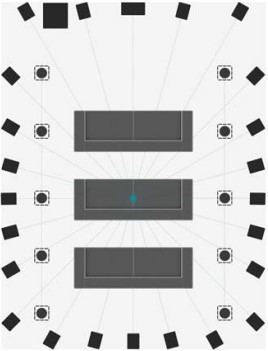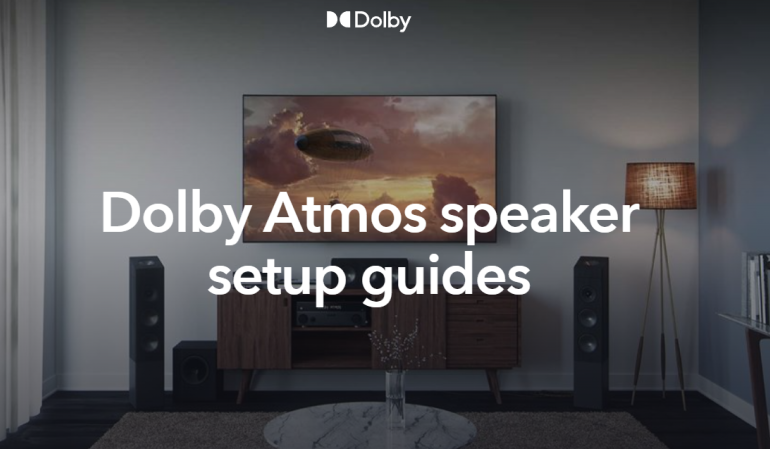Dolby Updates Speaker Placement Guidelines (But We Get No Credit)
I have been an audio enthusiast since I spun my first record. My first home theater was installed in the early ’90s. It consisted of a rudimentary AV receiver and five floor-level speakers giving me surround sound! Unfortunately, we didn’t have the internet in the ’90s. So we had to rely on common sense and advice from our local HiFi shop to place our speakers around my single sofa. My basic speaker layout barely changed for a decade. But today, Dolby produces guides for every possible scenario, ensuring the best sound. And once again, Dolby has updated their speaker placement guidelines. Meaning that a legion of internet experts will argue that your speakers are in the wrong place. But are they? Let’s discuss.
What’s New With the Updated Dolby Speaker Placement Guidelines?
First, the new guidelines allow up to an 11.1.8 configuration placement and everything in between. Secondly, Dolby updated the speaker height placement options, allowing for more flexibility within your room. Lastly, Dolby relaxed the width of your overhead speaker placement, making them easier to place in less than ideal spaces.
If it’s not apparent, Dolby has finally begun to listen to some common sense (and the AV Rant Podcast). Dolby realized that not every room is a dedicated home theater. And applying strict height and width restrictions will not work in the real world!

Updated Speaker Locations – Real World Application
So let’s face it, very few people will take the time to read and try to understand the 60-page white paper provided by Dolby. So what do you need to know to get the most out of the updated Dolby speaker placement guidelines? How about some math, a little common sense, and a calibrated eyeball? Ok, and maybe a tape measure!
Editor’s Note: The whitepaper from Dolby that we link above still says 2018 at the top. We’re not sure why. But if you scroll down, you’ll see the text has been changed and the increased number of speaker options are now listed.
Speaker Height
Previous versions of the Dolby speaker placement guidelines recommended that side surround speakers be near or below ear height and directly to the side of your listening position. The overhead and rear surround speakers were to be in line with your front right and left speakers. This placement ensured a 42-48″ separation between your surround and overhead speaker so that the sounds don’t get muddled. However, Dolby failed to realize that not everyone is the same height and has identical sofas or furniture that would not block or obstruct the sound from surround speakers.
Well, rejoice, Dolby has finally seen the light (or listened to reason). Dolby now describes speaker placement as “A clear path: Create a clear path between you and your speakers. If you can’t see the speaker, sound is being blocked.” Oh, and if you can’t get everything at ear level or in line with your front right and left speakers? That’s fine; as long as they are no more than 1.25x the height of your front speakers, you are golden!
Speaker Width
As with speaker height, Dolby has relaxed their need for overhead and height speakers to be in-line with your main right and left speakers. With the new, updated speaker placement guidelines from Dolby, they say:
The horizontal width should be about the same as the horizontal separation of left and right speakers placed at ±30 degrees. If this guidance is followed, the overhead side-to-side separation should be 0.5 to 0.7 of the width of the overall layout, depending on the distance to the screen and the front three speakers, relative to the surrounds. It is best to keep the overhead arrangement centered, front to back, over the listening area, even if the front speakers and screen are at a greater distance than the surround speakers.
This new guide is particularly effective for enthusiasts who have their front soundstage widely separated. If your front speakers are widely separated, you can just take the width of the room or system and use their metric rather than making your overheads too wide as well. Our suggestion has always been to just have them a little wider than your couch. Seems like Dolby now agrees.
So What’s the TL;DR Version?
So for those of you who have never read one of the Dolby speaker placement guides, what’s the big deal? Basically, Dolby has realized that not everyone has perfect placement, and can’t achieve some of the rigid placements. Plus, most people are not willing to get out a tape measure and take multiple measurements to get the “best placement.”
By giving you the ability to place the speaker in a wider area, and by explaining it in more understandable terms, it takes a lot of the frustration out of placement. I remember having an entire page of diagrams, measurements, and calculations for my surround and overhead positions. But then I asked Tom and Rob at AV Rant. They told me “slightly above ear level for surrounds, and five to six feet away from your main listening point” for overheads. That advice allowed me to easily place my speakers. And guess what, I was pretty much on the money with my extensive diagrams and calculations. And with these new speaker placement guidelines from Dolby!
Our Take
Placing your speakers shouldn’t require an engineering degree and a graphing calculator. I realize the Dolby Install Guides and whitepapers are written for professional installers who value precision over using more common terms. But for your Average Joe, the new install guidelines should allow you to quickly figure out the best spot for your speakers and get you up and running in no time.
Plus, it proves we were right all along. And that always feels good!



Could you provide a link to the new guidlines? I only see a link to the 2018 version of the white paper.
Scroll down. That is the new guidelines. They updated the text but not the year at the top. Confused me at first as well.
Thanks for the clarification and the mention on your podcast. I was driving in my car listening to that episode and thought to myself, “Hey, I’m the guy who made that comment!” Haha! 😀
No problem. And thanks for pointing that out! I’m sure you are not the only one that was confused.